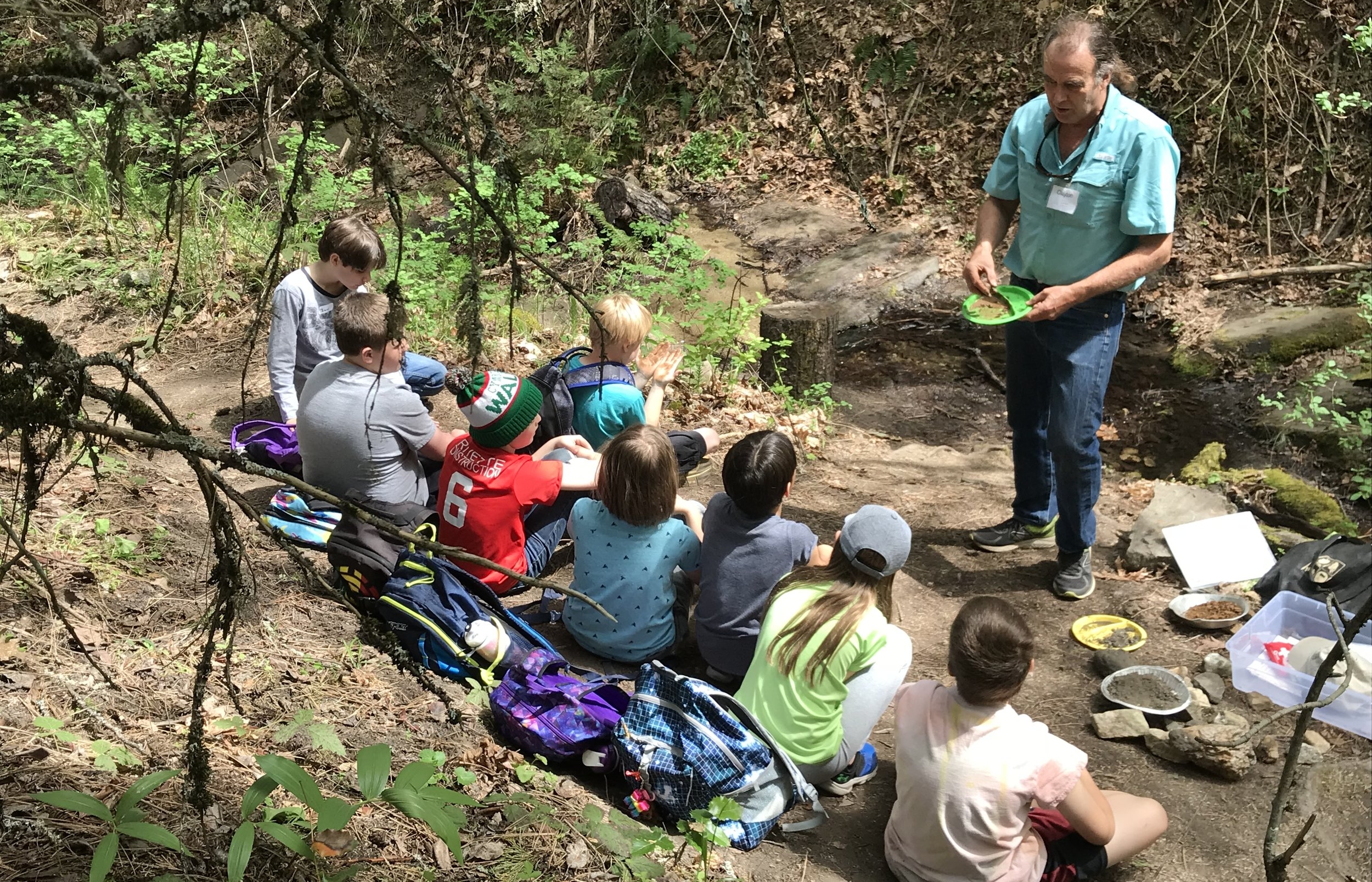Learning from a stream instead of a screen
By John Darling / For the Tidings
Ashland Daily Tidings, April 27, 2018
In a field school called “Loving the Land,” dozens of fourth and fifth graders broke out of classrooms for five hours Friday and, amid much appreciative shouting, got to inspect a range of amazing phenomena in Ashland’s Oredson-Todd Woods that, to the unschooled eye, just look like a bunch of dirt, trees and a creek.
Volunteers and staff of Southern Oregon Land Conservancy set up three stations — geology, trees and stream-dwelling macroinvertabrates — and invited a couple dozen Walker School youngsters to put away their cellphones and look more closely at Clay Creek (it runs out of the hills down along Clay Street), a stream that just happens to be the divider between two radically different kinds of geology, explains Clayton Gillette of SOLC.
Perched by the bank of the tiny creek, the kids begin to grasp that one side is granitic from “plutons” pushing up out of the Earth’s reservoirs of magma, and slowly cooling, while the other side is sandstone sediment, formed on the bottom of the ocean that used to cover Oregon.
Photo credit SOLC.
As proof, Gillette grabbed a rock, displaying clamshells fossilized on the ocean floor, which pushed up to form much of Oregon 70 million years ago. Lava flows from Cascade volcanoes came last — and that’s how Grizzly Peak got here.
Geology happens over billions of years but, he told the kids, it can happen quickly, as shown by a big hump in the trail they walked. How did it get here? Gillette invited the kids to look upslope. A huge gob of earth had “slumped” out and pushed downhill into Clay Creek during the New Year’s Day flood of 1997.
You could almost hear jaws drop as he explained how a young fir on the trail’s edge used to be upslope, but the landslide moved it, roots and all, leaving it at a wild angle, from which it now tried to grow vertically.
“There is so much of this they won’t remember, but you just never know what will stick with them and what will become of it,” says Gillette, in an aside.
Photo credit SOLC.
Putting on rubber boots, the entranced kids mucked about in the stream bed, grabbing out gobs of organic stuff, from which, using a sieve, they were invited to search for a traces of macroinvertabrates (big bugs). They found traces of dragonflies, water striders and beetles — and even a tiny hummingbird egg (it had been cracked open). The egg, found by student Jarred Townsend, caused the most buzz on the jaunt.
“I learned a whole bunch about the different minerals, like the rose quartz in granite, but the hummingbird egg was the best,” he says.
Krista Morgenthaler of SOLC started the day with an Indian legend about how “Madrone Girl” and her boyfriend, the north wind, fell in love and became the madrone.
Students hiked up the canyon to a waterfall to work on quiet reflective activities.
“The great thing about this is it’s hands on, direct experience and, hopefully, for some, it will also bring their parents out here,” said SOLC volunteer Judith Anne McBride, a retired area teacher.
Of her daughter, Aspen, mom Corissa Peterich said, “This is good for her to learn respect for the land and conservation of the environment. I love it, watching the children expand their education and develop a deeper love for nature.”
Native Ashlander Landon Craker, dad of Alexandria, said he grew up in the woods here and “we’re outdoors kind of people. She loves nature and is enjoying this whole thing.”
Loving the Land, now in its 13th year, is staged annually for five days for elementary students in Ashland, Talent and Phoenix. It is supported by a grant from the Ashland Parks Foundation and the Rotary Club of Ashland Lithia Springs.
The Oredson-Todd Woods is protected through a conservation agreement between the city and SOLC. The property was donated to SOLC in 1982 by Vince Oredson and John Todd and later given to the city for natural parkland. It is next to Siskiyou Mountain Park, another conserved property. For more on SOLC, email info@landconserve.org or go to landconserve.org.
— John Darling is an Ashland freelance writer. Reach him at jdarling@jeffnet.org.







